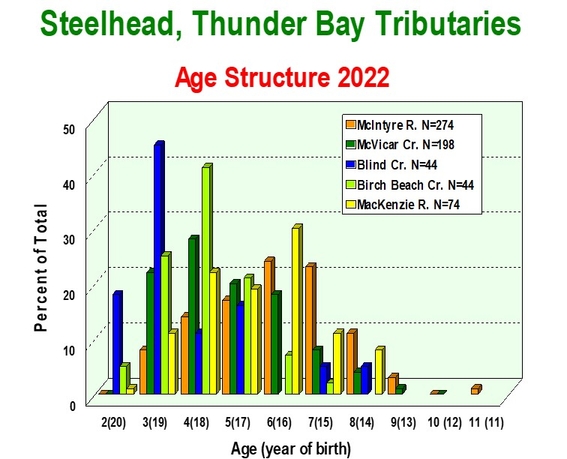Cooperative Angler
The Co-operative Angler Program involves volunteer anglers biologically sampling their daily steelhead catches. It is a partnership between the Upper Great Lakes Management Unit of the Ontario Ministry of Natural Resources and Forestry (OMNRF) and the North Shore Steelhead Association (NSSA). The purpose of the program is to collect annual life history and population information on wild steelhead populations in tributary streams of Lake Superior. The science collected can be applied to managing wild steelhead stocks now and in the future.
The Co-operative Angler Program is conducted annually in the spring (April to June) on adult steelhead in Lake Superior tributaries. Each participant receives a sampling kit (measuring tape, knife, scale envelopes and instruction sheet) along with a scientific collectors permit issued by OMNRF. Steelhead anglers record the length, sex, and take a scale sample from each fish they catch. In a few pre-determined tributaries, steelhead are also marked with a fin clip and tagged. The mark (fin clip) allows us to estimate the adult steelhead population size by using a mark / recapture or Petersen estimate. Tagging monitors movement patterns, harvest and ageing accuracy. At the end of the season the data is collected by the NSSA. Life history strategies of each steelhead (number of years as parr, number of years as smolt, age at maturity, number of spawning events, total number of lake years and total age) are extracted from the scale samples. Data is then analyzed and a report is published on the NSSA web site. The OMNRF and NSSA share the data and the cost for the program.
Executive Summary
The information gathered from the Co-operative Angler Program provides the Ontario Ministry of Natural Resources and Forestry (OMNRF) with insights into Steelhead year class strength, recruitment, exploitation rate, size-at-age information, movement patterns, ecological interactions with other species and trends in population size. Of particular importance are the population estimates generated by the use of mark-recapture techniques (often referred to as ‘clipping’) on the McIntyre, Neebing, McVicar, MacKenzie and Portage Creek tributaries. Marking fish with a fin clip is an established and accepted fisheries assessment tool that shows little adverse effect to the marked fish.
About the Program
During the initial stages of this program, biologists with LSMU and the Science and Information section of the Ontario Ministry of Natural Resources (OMNR) organized workshops to provide training for those anglers interested in collecting biological samples while involved in recreational fishing. Training was necessary to ensure that the appropriate techniques were employed to provide valid and consistent information, and to reduce mortality as a result of increased handling. History Since 1991, Steelhead monitoring has been undertaken by the Ontario Ministry of Natural Resources and Forestry (OMNRF) in partnership with the North Shore Steelhead Association (NSSA) to gather information about the health of various Steelhead populations found along the North Shore of Lake Superior. Prior to 1991, very little information was known regarding the status of North Shore Steelhead populations. To help provide fisheries managers with data that could be used to evaluate the status of Steelhead populations, the OMNRF partnered with the NSSA and collaborated with other fisheries specialists to come up with a way to monitor the Steelhead populations on an annual basis. The program used to gather this information is called the Co-operative Angler Program. Data collected from 1991-1996 suggested that many populations were over-exploited, likely due to the 5 fish daily limit of Steelhead. In 1996, the limit changed to 2 Steelhead with one allowed to be less than and one allowed to be greater than 51cm. In 1999, the harvest limit changed again to 1 Steelhead of any size from the Pigeon River to the Pic River, except for the Neebing/McIntyre Rivers which adopted a 1 over 69cm size limit. The purpose behind the 1 over 69cm regulation in the Neebing/McIntyre Rivers was so that nearly all Steelhead would be able to spawn at least 1 time. The size-at-age information used to justify this regulation was collected by the Co-operative Angler program. Without getting into too much detail, Steelhead exhibit a very wide range of life history strategies which strongly influence their size. Some Steelhead are approaching 69cm at their first spawning run, therefore this regulation would protect those large maiden (first time) spawners from potentially being harvested, at least during their first migration. By protecting Steelhead from being harvested for at least one spawning run we can promote genetic diversity within the Neebing/McIntyre populations which is very important. Since the 1 over 69cm regulation was put in place, the adult Steelhead population in the McIntyre River has increased from approximately 400 (1999) to over 3000 (2020). The increase in the population is likely a result of reduced harvest as well as a catch-and-release mentality adopted by many anglers on this system when they catch legal sized fish. Although historic population estimates do not exist on the Neebing River, the current population estimates are fairly similar to the McIntyre River suggesting that the Neebing River has also likely benefitted from this regulation and catch-and-release practices. Without the Co-operative Angler Program, there would not have been data to support the 1 over 69cm regulation or any data to show that the population has increased over the last 20 years.
Steelhead Assessment Reports
Three steelhead assessment projects are currently being conducted - McIntyre River Steelhead Population Assessment, Portage Creek Steelhead Population Assessment & Co-op Angler Study. All studies are conducted in partnership with the North Shore Steelhead Association, and the Ministry of Natural Resources.


